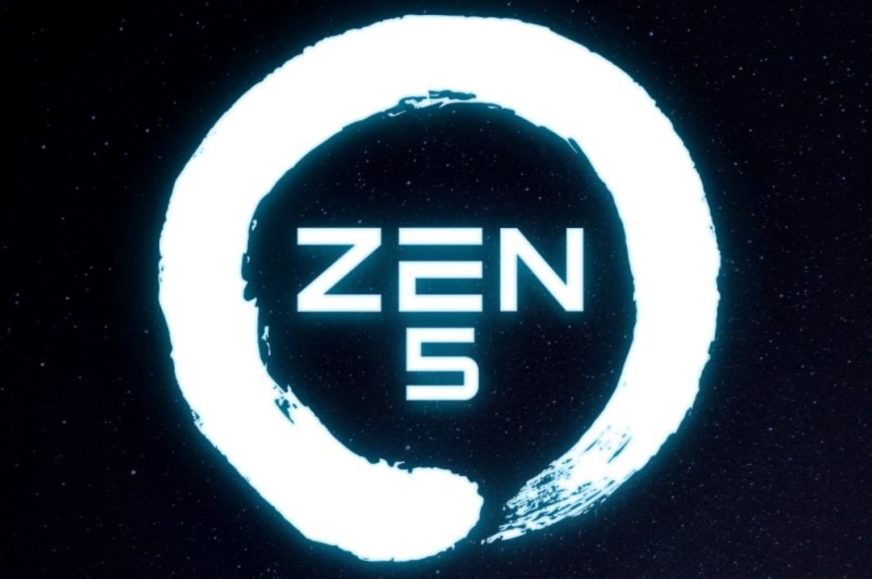AMD processor roadmaps for 2022, 2023 and 2024 officially revealed
From AMD’s Financial Day 2022 conference on Thursday, we’ve already covered here what the company said that was new about Zen 4 and Ryzen 7000 (especially the IPC reveal). Now let’s take a look at the roadmaps for future processors. The company has revealed these plans for practically all market segments, which comes after a long time during which we didn’t see any roadmaps from it and could only rely on unconfirmed leaks.
We’ll start with an overall roadmap of processor architectures – meaning the cores themselves, not specific processors. For now, AMD has shown a roadmap ending in 2024, which includes Zen 4 and Zen 5. So it’s not clear yet that there will be a Zen 6 core (but there probably will be).
Roadmap of Zen CPU architectures
The new content of the roadmap starts with the Zen 4 generation. We’ve known for some time that Zen 4 will have a “compact” version of Zen 4c designed for cloud servers.
This will be used in the Epyc 7004 Bergamo processors and seems to involve a smaller L3 cache and probably other modifications to reduce die area and increase power efficiency (at expense of lower peak performance). However, it is supposed to support all the instructions that the full-fledged Zen 4 can do (which includes the AVX-512).
But the roadmap now confirms that there will also be a Zen 4 with 3D V-Cache alongside the Zen 4c and the base Zen 4. This technology is therefore going to continue being part of AMD’s strategy.
The second new information is about the production process. AMD says in the roadmap that Zen 4 will be manufactured on a 5nm process, but in addition to that also on 4nm technology. This is a surprise, because the Ryzen 7000 and Epyc 7004 (both Bergamo with Zen 4c and Genoa with standard Zen 4) are definitely 5nm according to previous officially communicated information.
But AMD has now revealed that the mobile version of Zen 4 codenamed “Phoenix Point”, which will launch in the Ryzen 7000 generation, will be manufactured on a 4nm process – presumably TSMC’s N4 technology. This isn’t some radical change, the N4 process is an improved derivative of the 5nm N5 process and there is some compatibility between the two. But it does mean that these processors will benefit from slightly better silicon properties.
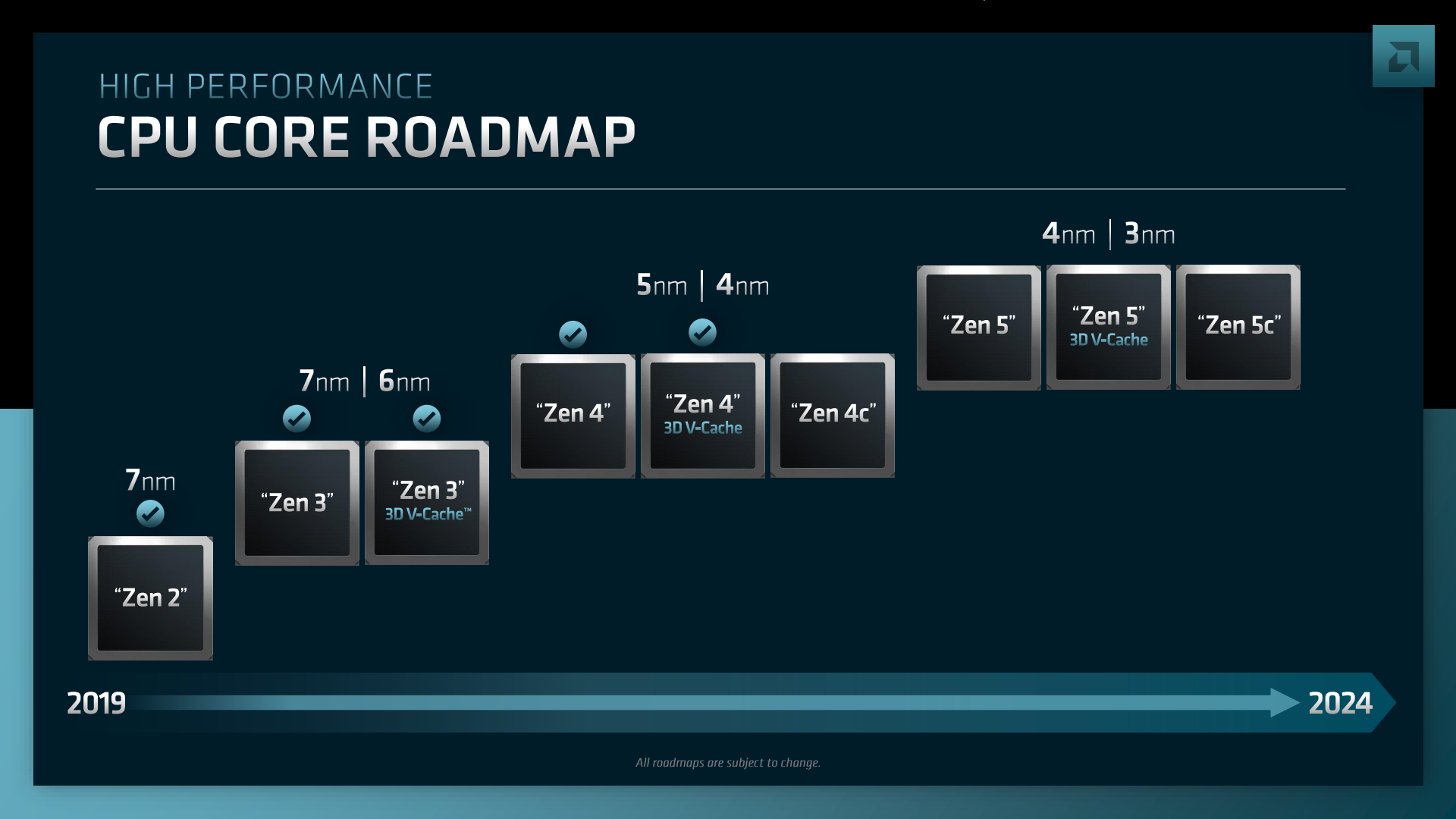
Zen 5: a major architectural change
The next generation of CPU cores, Zen 5, will also have three versions of the architecture. We will also see the basic Zen 5, a version with 3D V-Cache and a Zen 5c core with reduced die area and improved efficiency. This is again likely to appear in cloud server CPUs, but it’s possible that the company will also use it one day in low-end CPUs that will follow on from the Mendocino APU, which will go on sale later this year and features a slimmed-down version of Zen 2 that is perhaps a bit of a precursor to Zen 4c and 5c. And it’s possible Zen 4c/5c may make it into hybrid big.LITTLE processors, if AMD plans them.
According to AMD, processors with Zen 5 cores will be manufactured on 4nm and 3nm process. So again there is a mix of technologies, but here it has more significant consequences, because they are no longer derivatives of the same generation. 4nm/5nm process and 3nm process are two separate technologies of different generations. We don’t yet know which processors AMD wants to produce using which process.
What is important for Zen 5 is that it will again be a major upgrade of the architecture. One could say that it will be a fundamentally new core, although this is not entirely accurate, because even these new cores take over some elements and techniques from the previous ones. AMD’s approach with the Zen line of cores is to make big changes in one generation of core, where they redesign or reconceptualise a number of parts. This “big” architectural change generation is then followed by a second core that uses the same basic concept, but improves on its various sub-aspects or things that were found to have potential for further improvement during the development of the first core. Sometimes it may mean fixing bugs found in the previous core, or implementing features that were planned for the original core but were late and missed the deadline. These evolutionary architectures should typically yield less dramatic changes and smaller IPC increases.
Zen 1 and Zen 3 were the representative of the first case of new cores, and Zen 5 will be the next new one, so we can expect a lot from it. Zen 2 and Zen 4, on the other hand, represent those evolutionary architectures. Accordingly, AMD has previously said that although it also expects good results from Zen 4, Zen 5 will be a bigger deal than Zen 4, relatively speaking. Mike Clark, one of the chief architects of Zen core development, some time ago indicated that he thought Zen 5 was the most exciting generation yet. Let’s hope this “hype” will be matched by results…
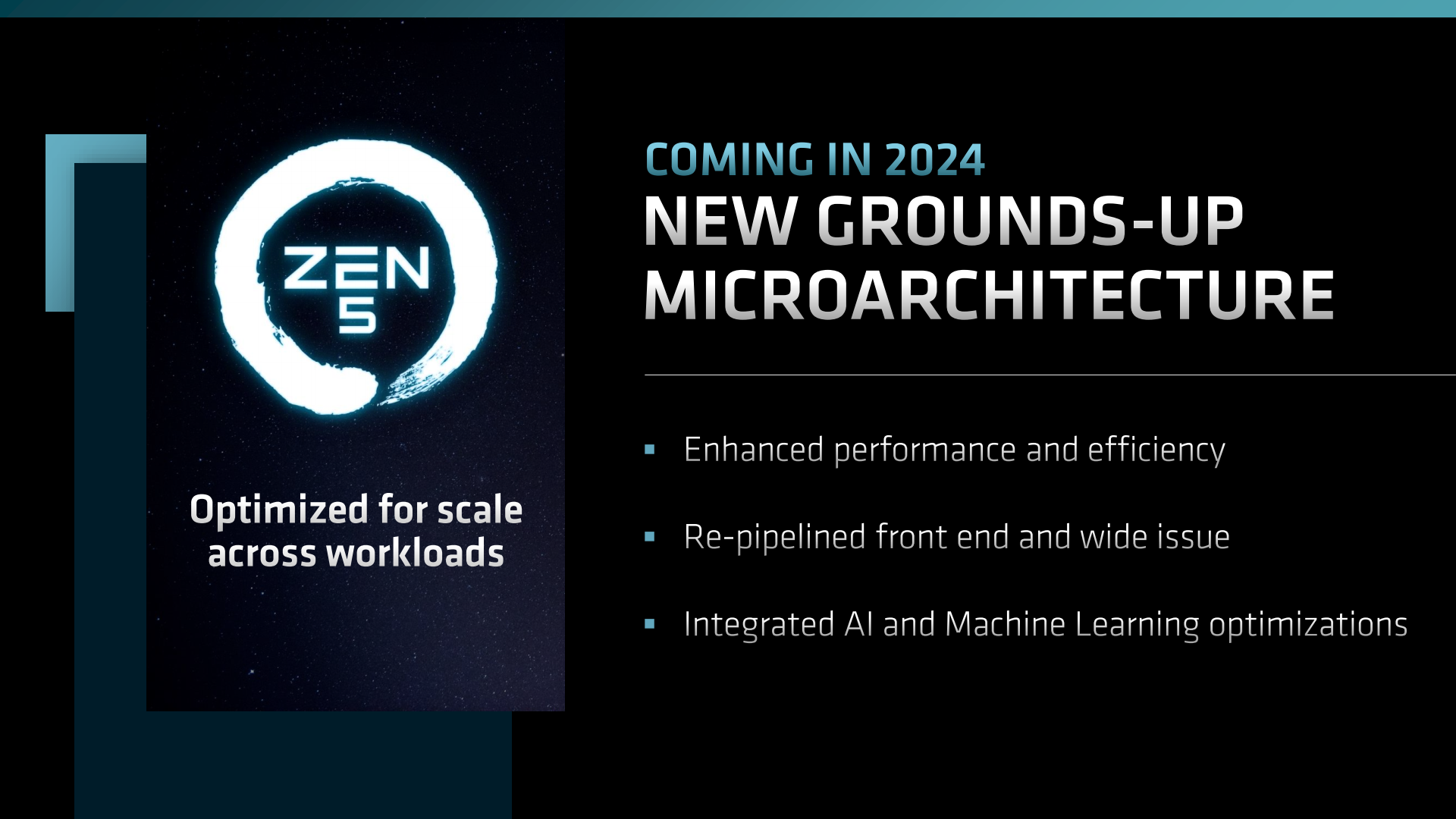
Changes in the core: pipeline changes, focus on higher IPC
But so far the company has said very little on how exactly Zen 5 will be innovative and what will change. The architecture is supposed to have improved performance and energy efficiency. That’s more or less a mandatory, automatic thing. And it’s supposed to be optimized to suit a wide range of tasks. That’s supposed to include improved performance in AI and machine learning tasks – again, we’re apparently talking about additional instruction extensions specialized for AI computing, perhaps adopting Intel AMX instructions or some custom equivalent.
The most important piece of information is the middle bullet in the short list you see on the slide, talking about “core frontend re-pipelining and wide issue”, as vague as that is. What is meant by that? The frontend of the processor refers to the part that performs the fetch of instructions from the L1 cache, decoding them (in instruction decoders), which are the very parts that are affected by the complexity of the x86 instruction set. Therefore, in some ways, it is in these stages of the CPU pipeline that x86 processor engineers have the hardest job with. And frontend also includes the branch predictor, another critical factor.
Re-pipelining could mean that the distribution of work into different pipeline stages changes, and even the number of stages could change, which are the far-reaching changes made in new cores compared to evolutionary architectures. If AMD extended the pipeline (added stages), it could increase the CPU clock speeds achieved. If the count is reduced, it will have the opposite effect, but again, it may also increase IPC. A pipeline with a low number of stages seems to benefit a lot from the IPC of, for example, ARM’s Cortex cores.
The mention of the “wide issue” then directly indicates that Zen 5 should be designed for increased IPC. What AMD meant by “Issue Width” in Zen 3 was how many operations can be sent into its backend execution units (ALUs, AGUs) in a single cycle. So the issue width highlighted here could mean that AMD finally adds more units – the core could have more than the current four ALUs in the integer part, load/store pipelines could be added so that the core can handle more memory operations per cycle (Zen 3 supports a maximum of three). And the number of SIMD pipelines in the FPU part could be increased as well. More units is generally a prerequisite for a higher IPC. So this could indicate that Zen 5 will follow the same path of a wider core with higher performance per 1 MHz as Apple’s architecture or Intel’s Golden Cove architecture (Alder Lake P-Core processors).
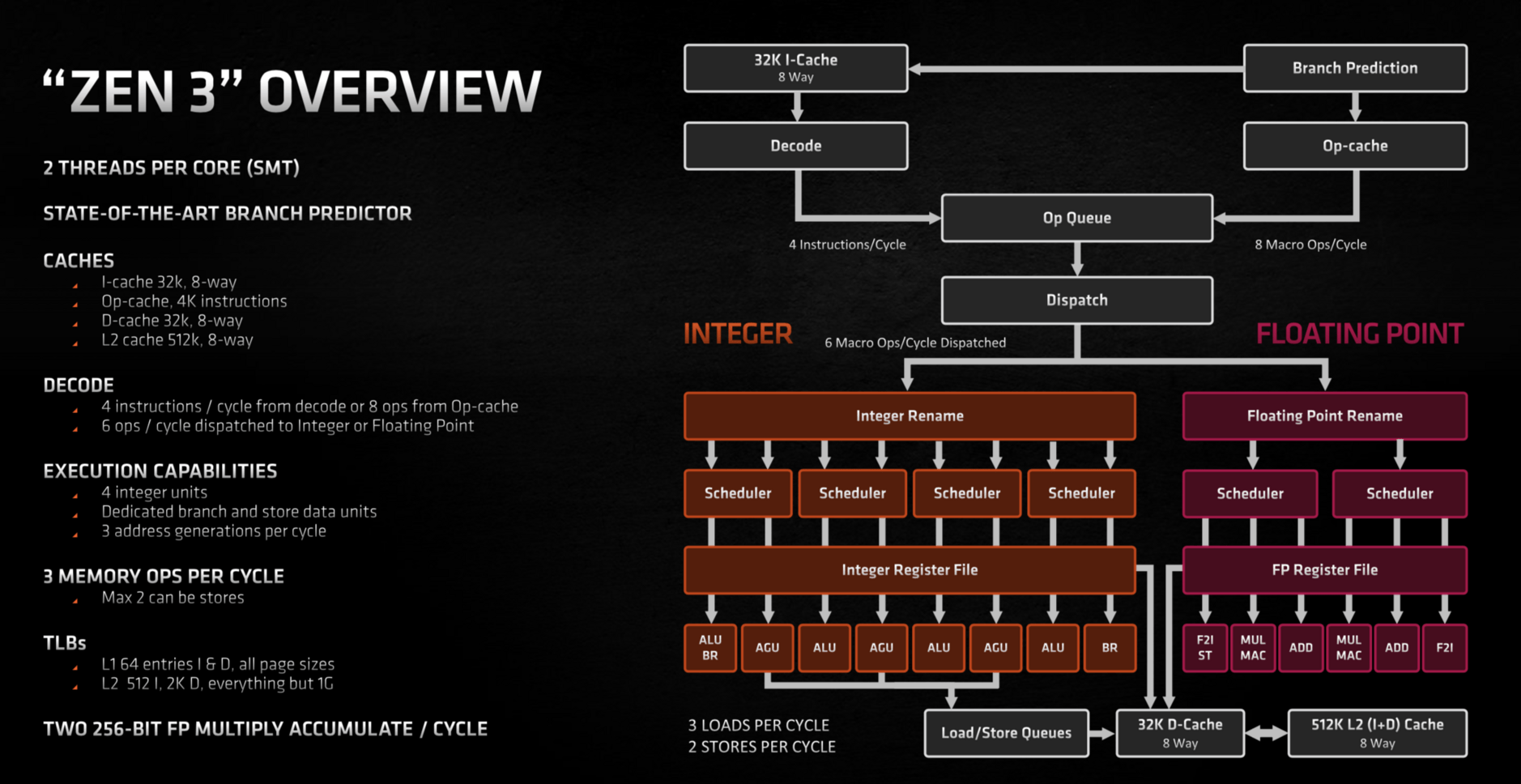
Zen 5 is not coming until 2024
Until now, it was cautiously believed that with a bit of luck, Zen 5 could come to market as early as the end of 2023, roughly a year after Zen 4 (new architectures can come out after a shorter wait than evolutionary ones – this is because while an evolutionary architecture depends on the completion of its predecessor, the next new generation core is partially developed in parallel with its evolutionary predecessor). However, Zen 4 won’t come out until the fall of 2022 (not early summer like Zen 2), and pulling the interval down to a single year is probably not something AMD can do yet.
It has now been officially confirmed that Zen 5 processors will not come out until 2024, although it may be in the first half of that year (if the interval is about 18 months, as it was between Zen 2 and Zen 3).
Processor roadmaps: desktop
In addition to the architectures themselves, AMD also showed roadmaps of products that will be based on Zen 4 and 5 cores. We’ll take a look at the desktop first. The roadmap shows that for the desktop socket AMD is preparing regular Ryzen 7000 with Zen 4 architecture (these have the codename Raphael, which is however not listed on the slides) as well as processors with 3D V-Cache. Something that is not in the company’s materials, but mentioned by unofficial leaks, is that there ould be more models in this generation than just a single octa-core for gamers (which is the situation now in the Zen 3 generation with the Ryzen 7 5800X3D).

But the roadmap also shows that AMD is planning a Ryzen Threadripper 7000 with Zen 4 architecture (but no mention of 3D V-Cache). I guess it’s also unclear whether they mean the regular cheaper Threadripper, the more expensive Threadripper Pro, or both.
AMD has less to reveal about the next generation based on Zen 5. Only one CPU is displayed so far – codenamed Granite Ridge. We already know this name, so it seems that this leak was true. According to it, Granite Ridge should be high-performance processor for the AM5 socket, which will be released under the Ryzen 8000 designation.
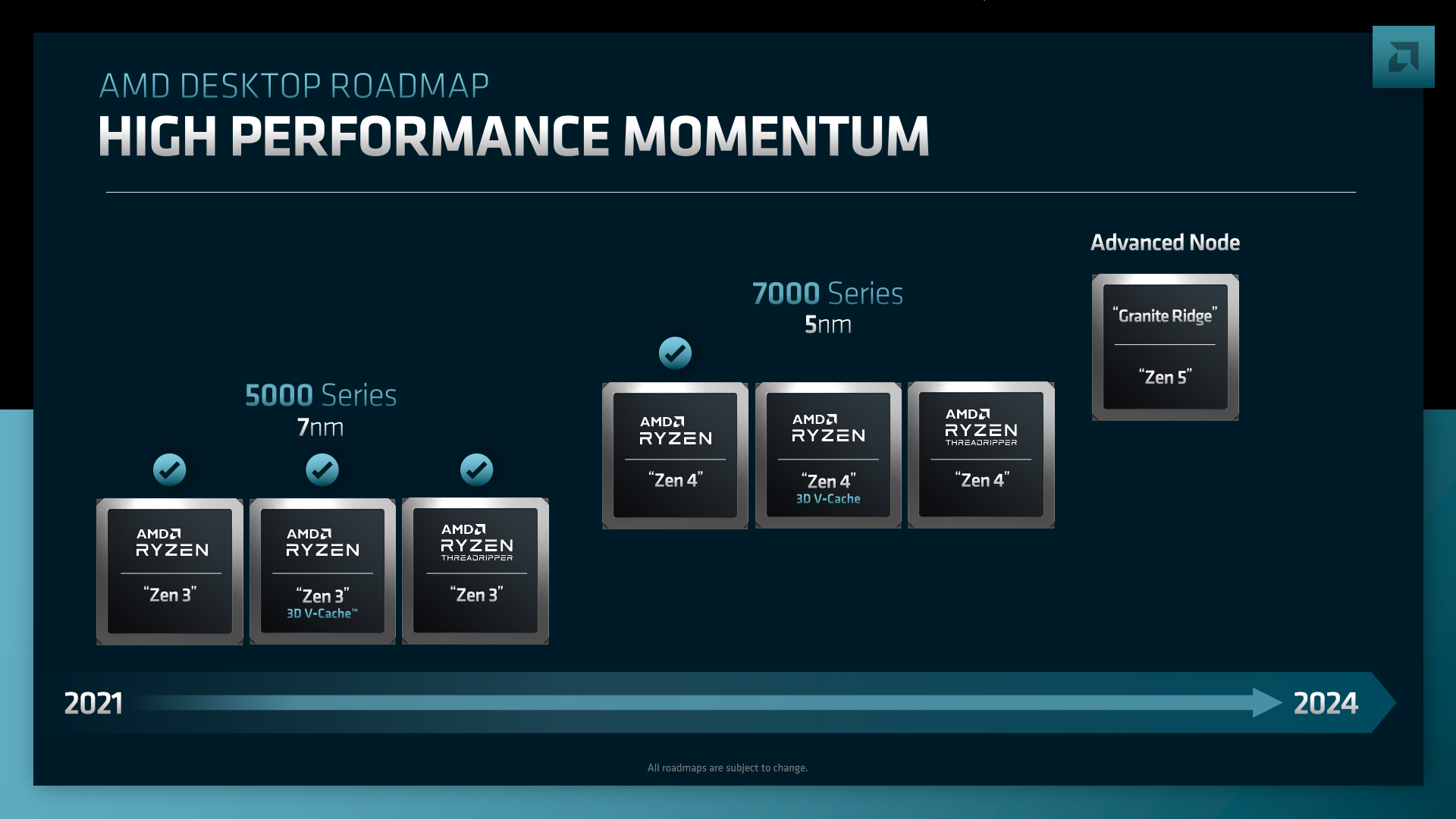
AMD now states only that these processors will be based on an “advanced manufacturing process”. So it’s not clear if the 3nm process is still on the cards, or if AMD has decided to convert these processors to the 4nm technology, which avoids risks of delays or yield issues that could happen with 3nm technology. The 8000 Granite Ridge Ryzens are probably due out in 2024. The 8000 Threadrippers aren’t listed here yet, which may mean AMD won’t be able to release them until 2025. But that’s just conjecture, they may be planning htem for 2024 and just not want to announce them like that yet.
This roadmap does not show a complete desktop roadmap, but only “high performance” desktop processors. So it doesn’t include cheaper processors for the AM5 socket, such as the APUs that would be derived from the notebook processors whose roadmap we’ll discuss now. However, AMD at Financial Analyst Day more or less ignored the area of the cheapest processors, such as the recently announced Mendocino mobile SoC. Therefore, what is shown here is not everything the company will sell in the future, you can say the roadmaps only present only what AMD wants to show off the most.
Ryzen 7000 and 8000 for laptops
What we were missing most till now is probably the laptop roadmap, because AMD hasn’t had any confirmed roadmap out in recent years. For example this year’s Ryzen 6000 was only known from leaks up till the the official release. But now AMD has confirmed the next two generations. Apparently, Phoenix Point processors are coming in 2023. This would apparently be the mobile Ryzen 7000. Phoenix Point will already have integrated graphics with the new RDNA 3 architecture in addition to Zen 4 cores, and AMD has confirmed that it will use a 4nm manufacturing process, unlike the desktop Ryzen 7000.
It will be followed by a generation with the Zen 5 CPU architecture. This is supposed to be manufactured with an “advanced process”, so we don’t know yet if it will be 3nm. These processors should probably be released as Ryzen 8000 and their codename is Strix Point. Once again, we have a 13-month-old leak being confirmed by this. At the time, that leak also stated that Strix Point would be big.LITTLE – maybe it could have small Zen 4c cores. But AMD isn’t mentioning that yet in the roadmap and only says Zen 5. The graphics is supposed to be “RDNA 3+” (an improved version of RDNA 3?).
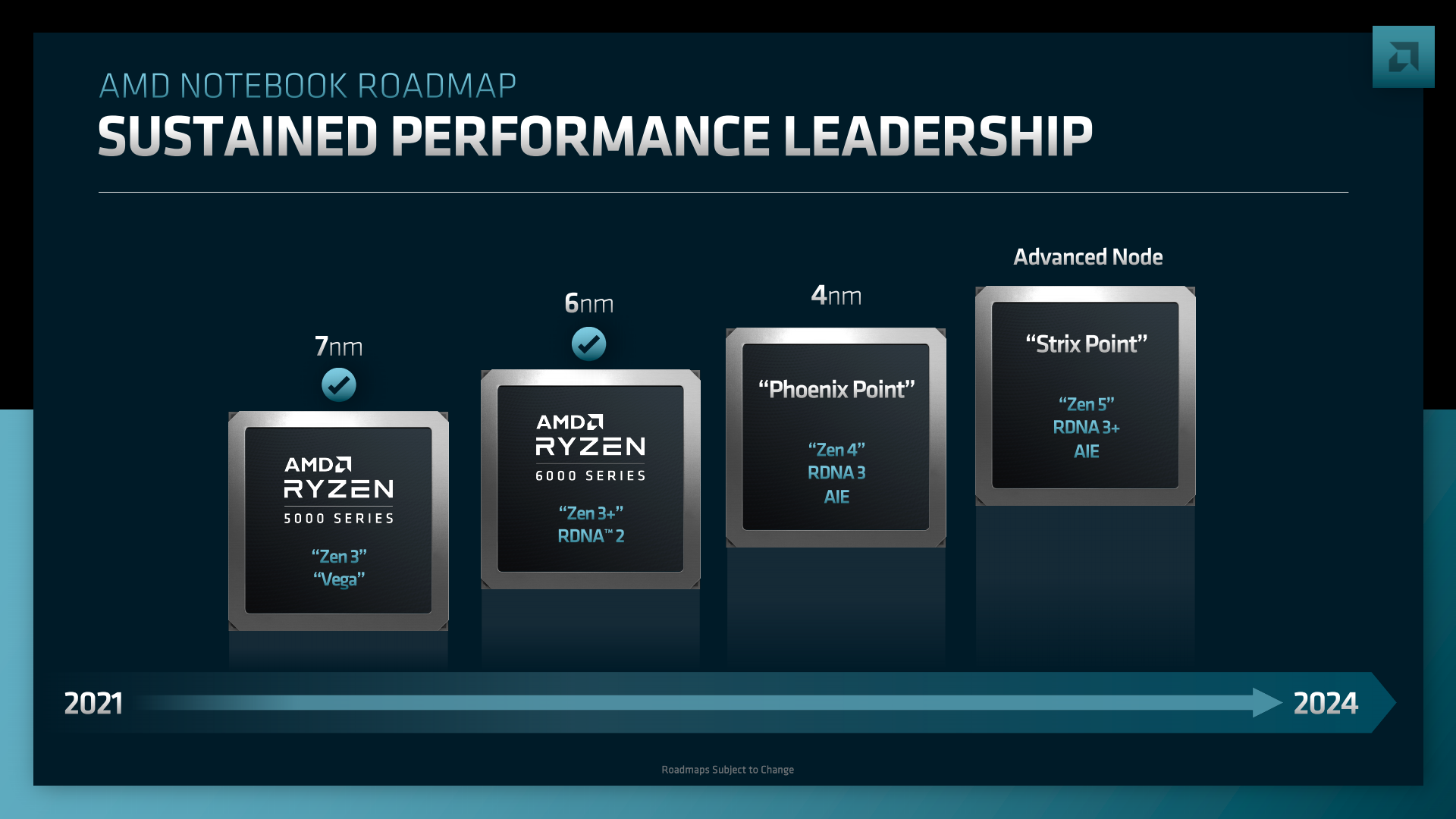
By the way, AMD seems to have a slight confusion in naming – the company has recently revealed a separate roadmap for high-performance mobile processors for gaming laptops and in it, these chips are only referred to as “Phoenix”. They have also been featured in unofficial rumours under this designation for some time – again, the new roadmap is perhaps confirming the veracity of those earlier leaks. The roadmap for gaming laptops also additionally lists Dragon Range processors, which are not mentioned in the Financial Analyst Day roadmap. Dragon Range should be the laptop version of the desktop Ryzen 7000 Raphael.
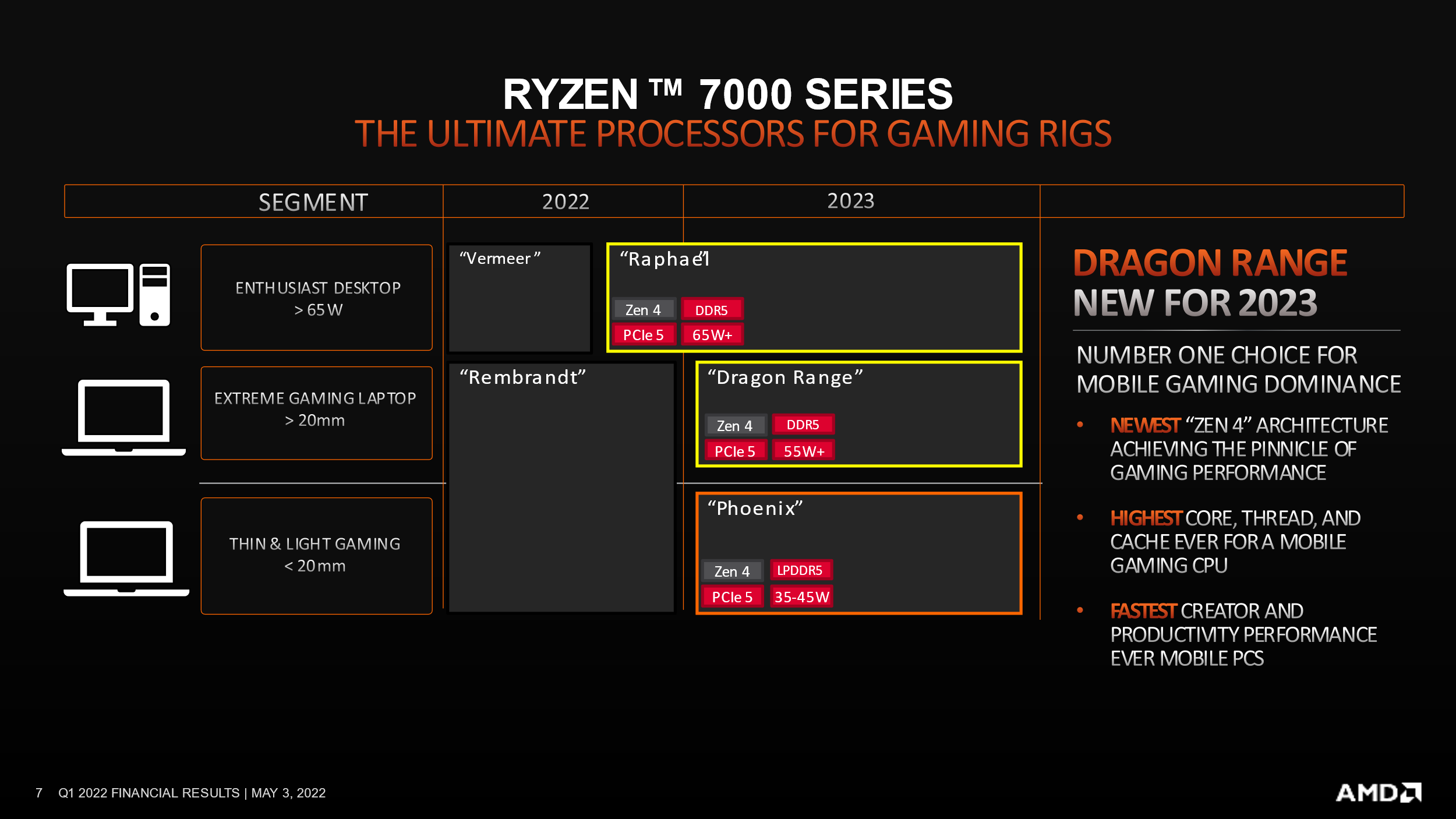
The Ryzen 7000 Phoenix Point and then the Ryzen 8000 Strix Point will be introducing one more new feature: “AIE”. This should stand for AI Engine, it’s a specialized neural network accelerator, probably similar to Nvidia’s tensor cores, and perhaps it could be based on Xilinx IP (or at least this technology has now been presented as part of the AI strategy of the Xilinx division).
Server processors: 96-core Zen 4 Genoa in Q4 2022
The roadmap of server processors will be very eventful. AMD seems to be preparing as many as four different versions of server processors with Zen 4 architecture. Three of them should use the same SP5 socket with a 12-channel DDR5 memory controller. We’ve known the base version for a while now – the Epyc 7004 “Genoa” will have up to 96 Zen 4 cores as well as PCIe 5.0 and CXL support.
AMD has now confirmed that the release of these processors is due before the end of 2022, sometime in the fourth quarter (Q4 2022). So they’ll come out fairly soon after Intel’s (delayed) next-generation Sapphire Rapids Xeons, which are a bit late and probably won’t start coming out until the second half of this year.
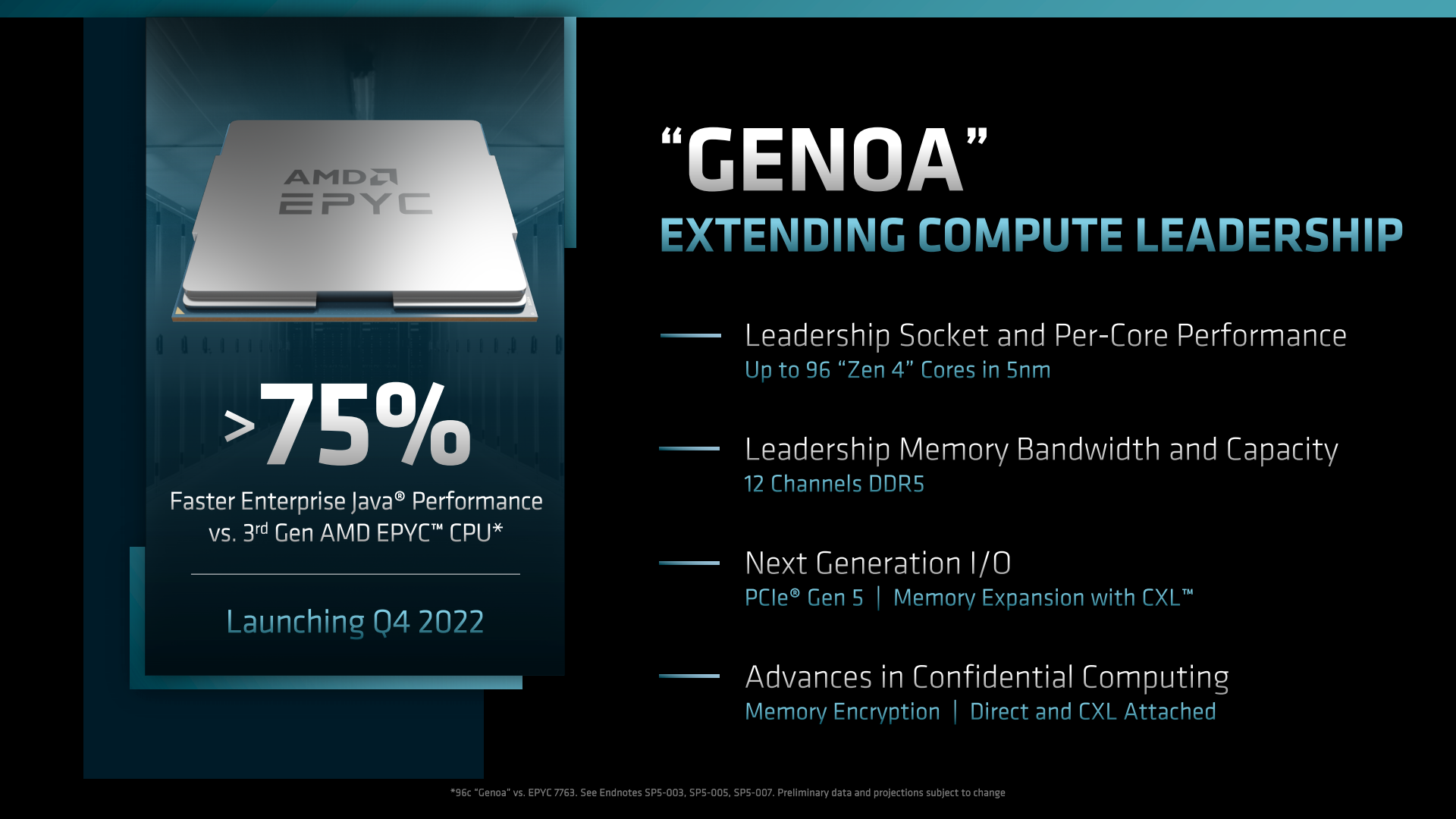
AMD also presented one benchmark: the Epyc 7004 Genoa is claimed to achieve more than 75 % better performance on a selected enterprise Java task. However, take this with a grain of salt for now, official benchmarks can be selective and represent best-case rather than typical scenarios.
Cloud Epyc Bergamo: Zen 4c still has SMT and AVX-512
The same socket and boards will be able to accept a version with lighter Zen 4c cores, the aforementioned Epyc 7004 “Bergamo“, which thanks to a more efficient architecture should have up to 128 cores and 256 threads (this is noteworthy, it means the Zen 4c core has not lost SMT), but retained support for all instructions and functions from Genoa processors. Thus, when using it, only the raw performance will change and 100 % software compatibility will be maintained.
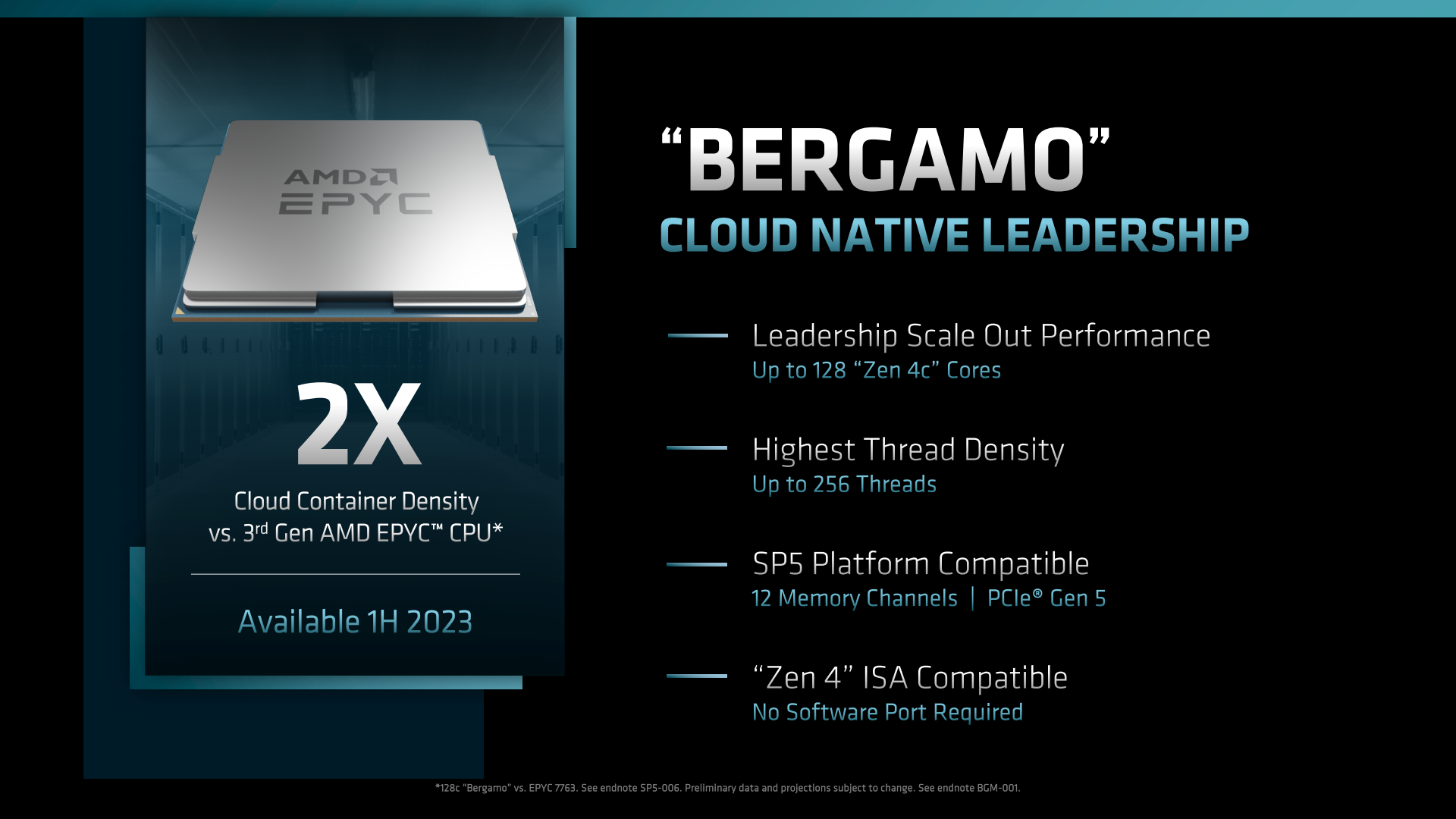
These processors are expected to go to market (be physically available) in the first half of 2023.
Genoa-X: Over 1 gigabyte of 3D V-Cache
In addition to these two variants, AMD has now announced two more. The first is the Epyc 7004 “Genoa-X“, which uses the vanilla, full-fat Zen 4 cores with extra 3D V-Cache added.
It is a continuation of Epyc 7003 “Milan-X”. AMD states that Genoa-X will also have 96 Zen 4 cores and over 1GB of total L3 Cache per processor socket.
I guess this could mean that the default version of Zen 4 will again have 32 MB of L3 cache per CPU chiplet with eight cores, and the chiplet with 3D V-Cache could contain 64 MB extra. Since there are 12 CPU chiplets, this would give a total of 1152 MB of L3 cache.
These processors are due out sometime in 2023 – AMD isn’t saying exactly when. Their large, high-bandwidth cache is supposed to be useful for engineering (CAD/CAM) and scientific (HPC) computing, but also for databases.
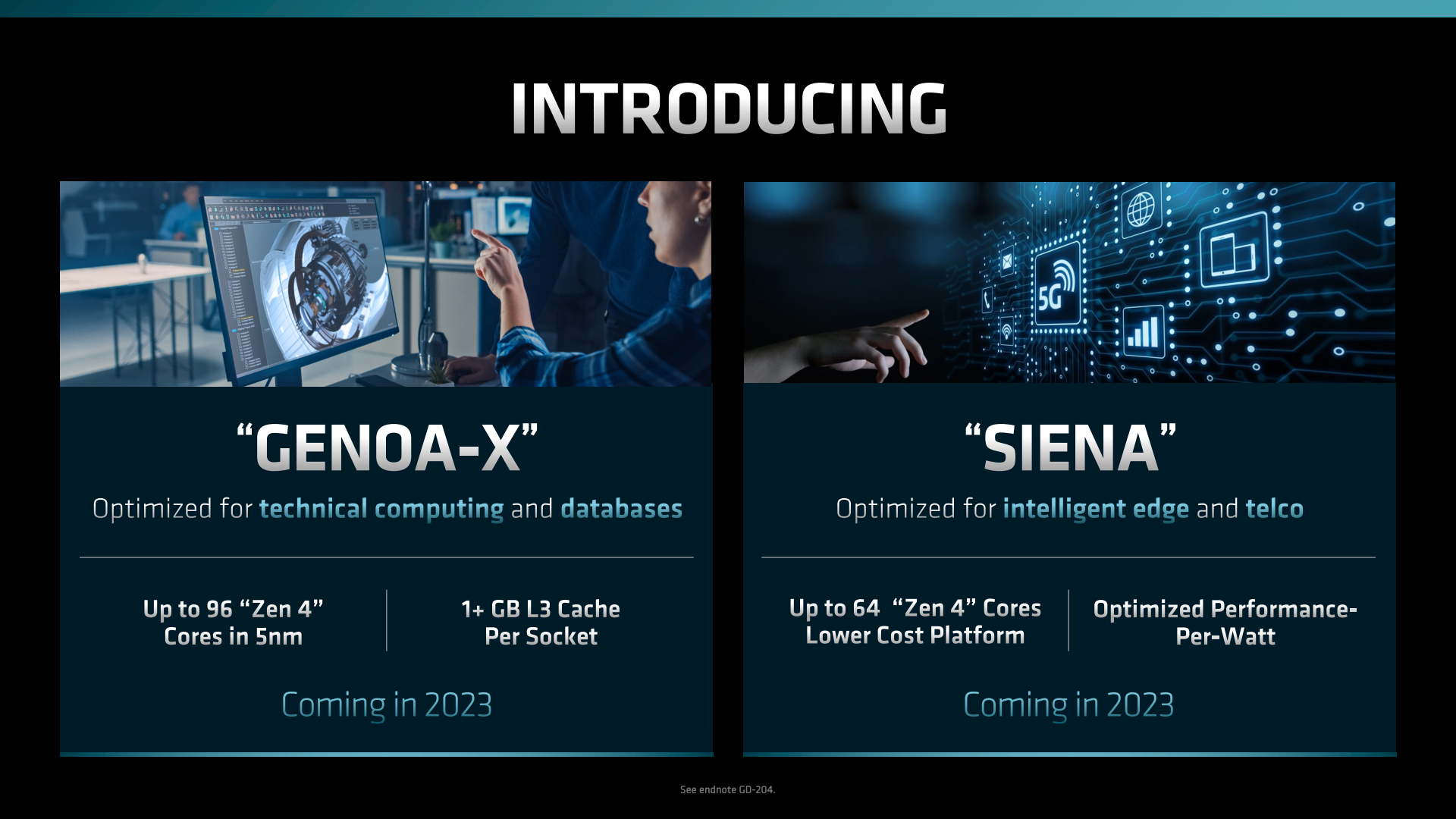
Siena: a cheaper SP6 platform?
But now AMD has also come up with a previously unknown new server product line: a cheaper version of 5nm Epyc, codenamed Siena, has been announced alongside the previous processors for the 12-channel memory platform. Here it might not bear the Epyc 7004 designation anymore, perhaps the name might be Epyc 5004 (but we’re just guessing).
Siena processors will have full-fat Zen 4 cores, but with a maximum of only 64. These processors are to use a cheaper platform. The current Epyc 7002 and especially 7003 have a problem with covering cheaper server segments, which is probably what Siena is supposed to solve. A cheaper socket will probably be used – maybe it’s the SP6 socket that has been leaked not a long ago. According to the leaks, it’s only supposed to support six-channel DDR5 memory and fewer PCI Express 5.0 lanes than the big SP5 socket. The Siena processors will probably have a lower TDP, they also might not be able to use 2S configuration but only 1S, and the boards for them should probably be cheaper overall. We’ll see if maybe those Threadripper 7000s will be based on this version of the Epyc 7004.
The release of the Siena processors is also expected to be sometime in 2023 with no further details. According to AMD, they should be designed for use in telecommunications infrastructure or embedded and “edge” servers, for example.
Zen 5 in servers as early as 2024
And finally, AMD also announced (or revealed in the roadmap) the fifth generation of Epyc server processors, the Epyc 7005. Unfortunately without much details, so we don’t know if the 3nm manufacturing process will be used. AMD states that this generation is codenamed “Turin” (all names for server generations come from Italian cities, as you may have noticed). We expect that Turin could be the name of the base version, the successor to the Genoa processors. Again, there will probably also be a Turin-X and some cloud and cheaper version coming alongside, but AMD doesn’t specify those yet.
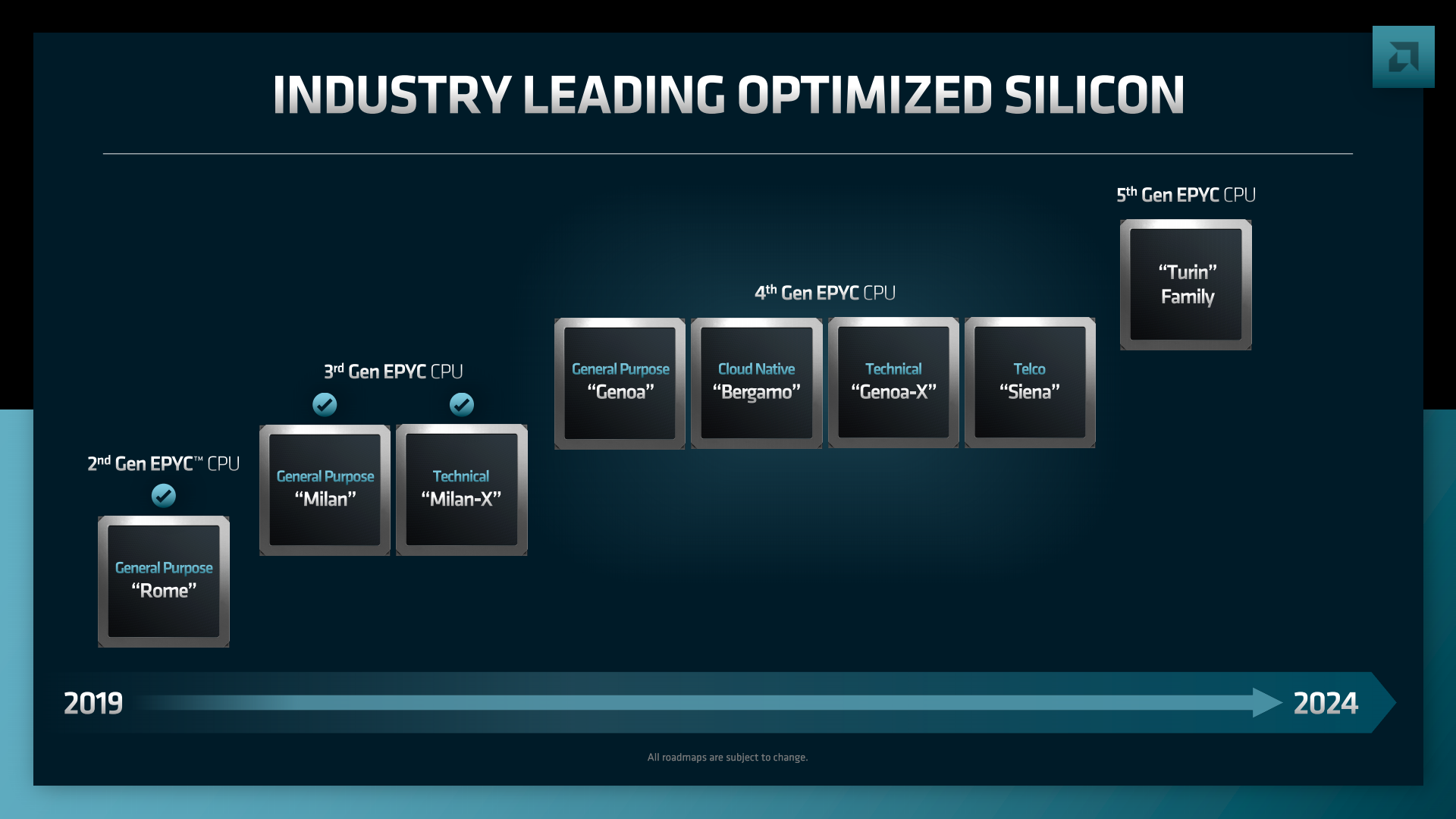
The Epyc 7005 Turin is said to be launched before the end of 2024, within two years of the launch of the Zen 4 architecture Epyc 7004. But again, it is possible that those specialized derivatives will not come out until later, perhaps only after the start of year 2025.
Sources: AMD (1, 2), AnandTech
English translation and edit by Jozef Dudáš, original text by Jan Olšan, editor for Cnews.cz
⠀





